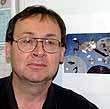Don Nelson asked: "I read this (liquid film gate projection) recently and there was no discussion as to what it is and why it is used."Kodak's invention of liquid gate projection is detailed in the paper "Liquid Gate for the Projection of Motion-Picture Film" by John R. Turner, Philip A. Ripson, Frederick J. Kolb, and Eric A. Yavitz, published in the February 1962 SMPTE Journal (pp. 100-105).
Like wet-gate printing, liquid gate projection submerses or coats the film with a solvent that has a refractive index similar to film base/emulsion, effectively hiding any scratches on the film surface. In the Kodak design, the total immersion gate also had the advantage of cleaning the print, cooling the print, and greatly reducing "focus flutter". The liquid gate projector was demonstrated at the SMPTE Technical Conference on October 6, 1961, and by all accounts, produced remarkable on-screen quality.
In 1973, the Academy of Motion Picture Arts and Sciences awarded the Class II award to WILLIAM W. VALLIANT of PSC Technology Inc. , HOWARD F. OTT of Eastman Kodak Company and GERRY DIEBOLD of the Richmark Camera Service Inc. for the development of a liquid-gate system for motion picture printers.
There was a device known as Pic-Clear that was used on 16mm projectors and telecines to clean prints and hide scratches:
http://www.broadcast.net/pipermail/broadcast/2000-December/019687.html
As Brad notes in his information on Film-Guard, coating a very thin layer of a material like Film-Guard on a release print also "fills in" surface scratches, making them less visible.
------------------
John P. Pytlak, Senior Technical Specialist
Worldwide Technical Services, Entertainment Imaging
Research Labs, Building 69, Room 7525A
Rochester, New York, 14650-1922 USA
Tel: 585-477-5325 Cell: 716-781-4036 Fax: 585-722-7243
E-Mail: john.pytlak@kodak.com
Web site: http://www.kodak.com/go/motion

 Home
Home
 Products
Products
 Store
Store
 Forum
Forum
 Warehouse
Warehouse
 Contact Us
Contact Us




 Printer-friendly view of this topic
Printer-friendly view of this topic











